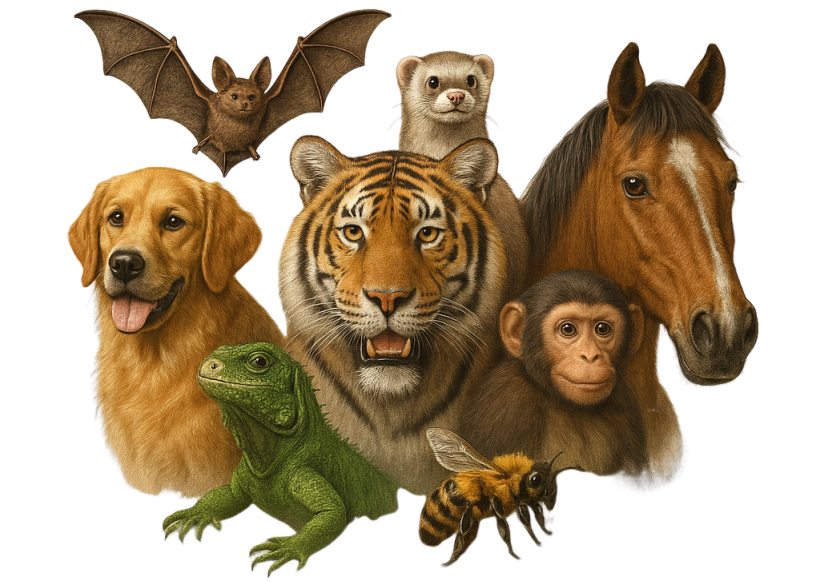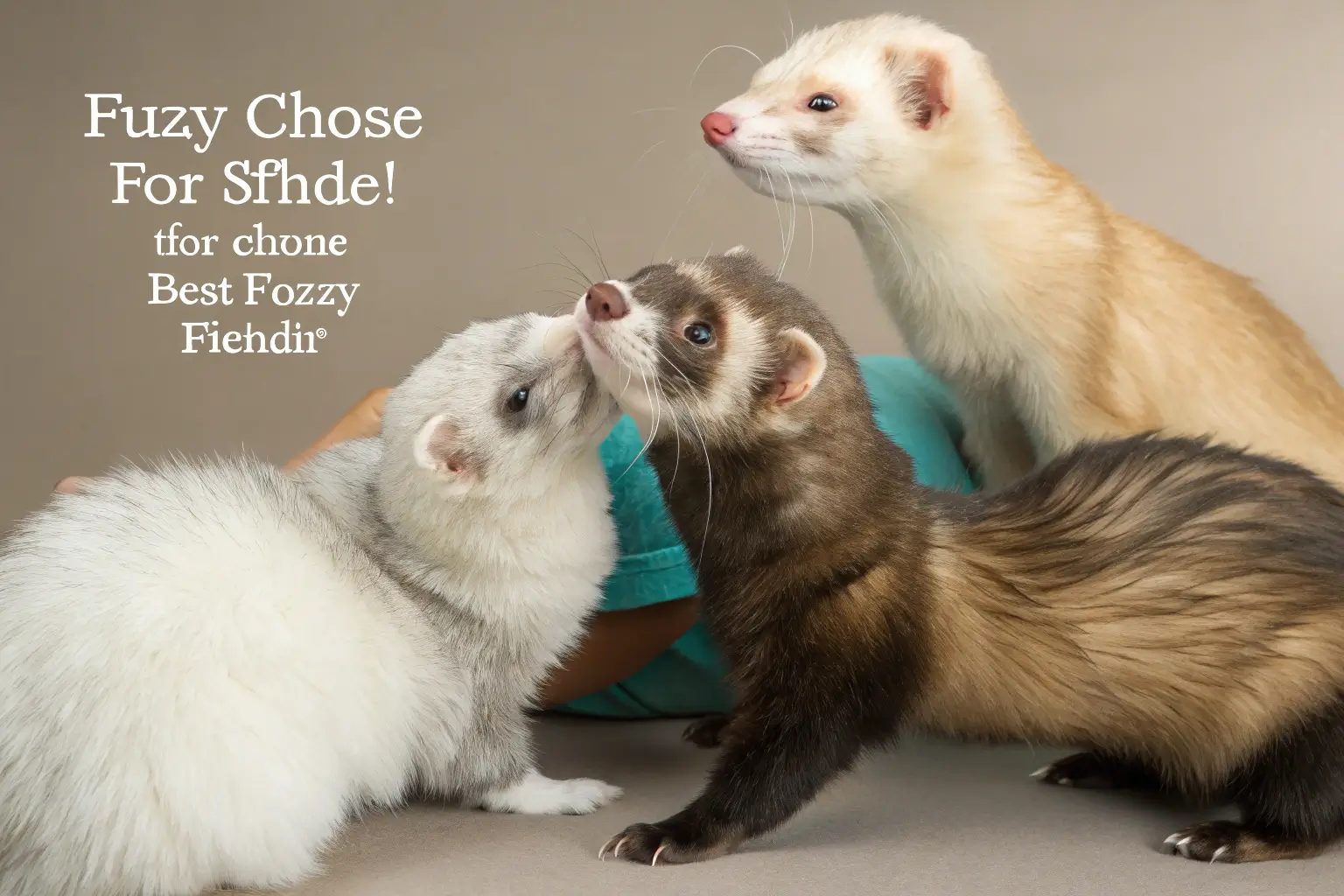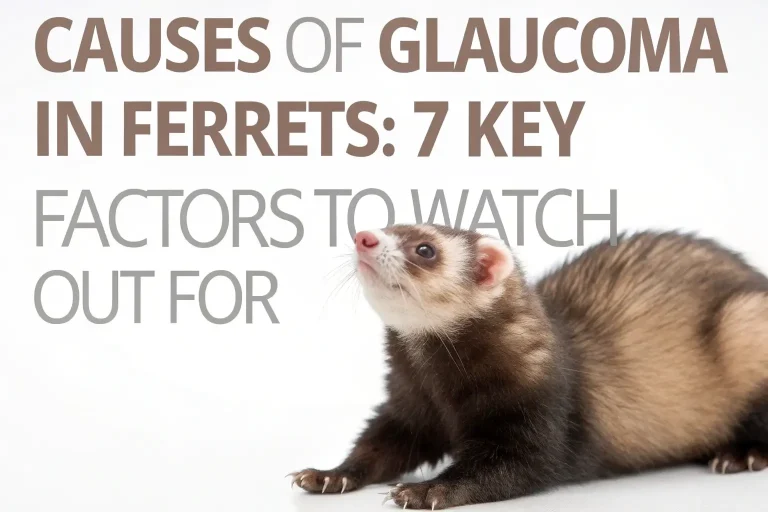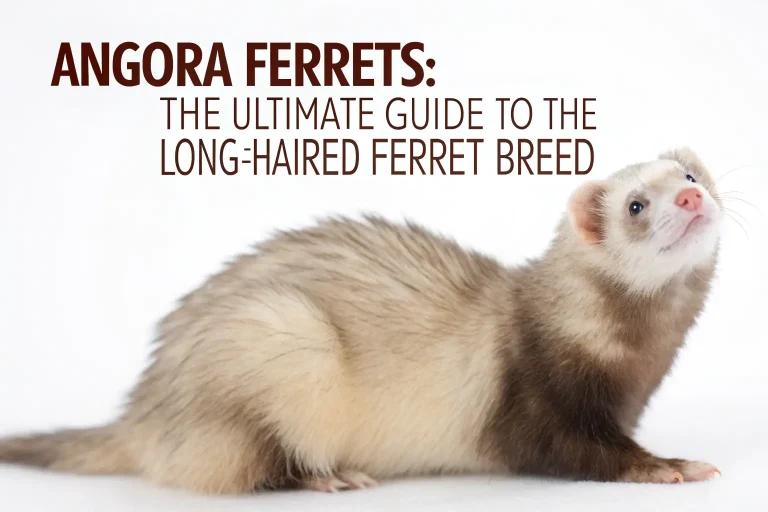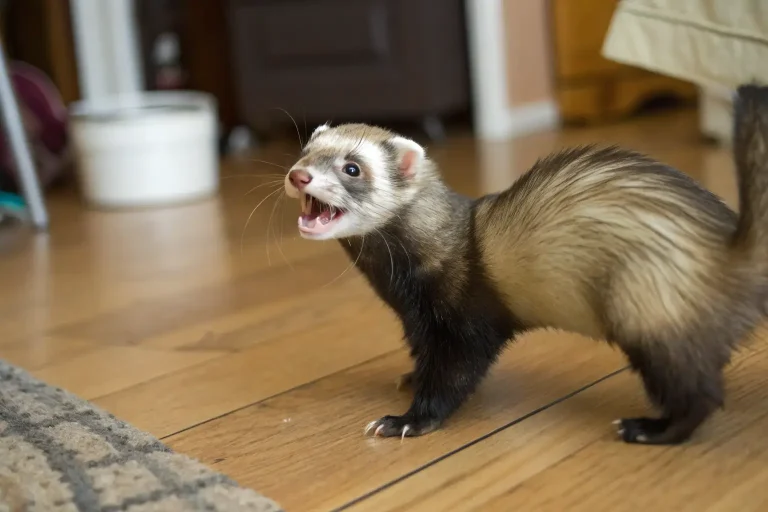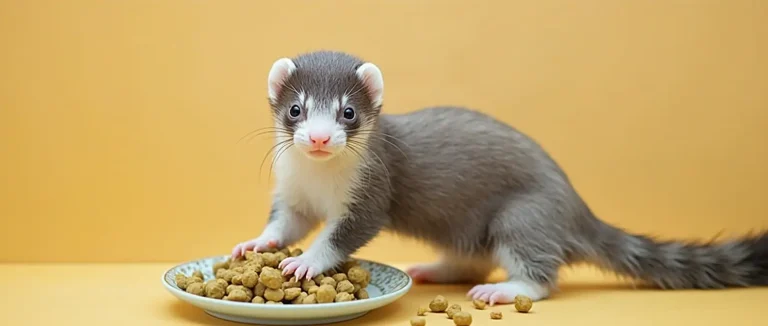Ferret Colors: How to Choose the Best Shade for Your Fuzzy Friend
Are you captivated by those playful, mischievous ferrets with their elongated bodies and curious personalities? When it comes to bringing one of these enchanting mustelids into your home, their color can be more than just an aesthetic choice. Ferret colors range from the classic sable to albino, panda patterns, and various point markings, each bringing its own charm and sometimes even specific care considerations. Understanding ferret colors and patterns is essential whether you’re a first-time owner or looking to expand your fuzzy family. In this comprehensive guide, we’ll explore everything you need to know about ferret colors to help you choose the perfect shade for your future furry companion.
Introduction
Ferrets, domesticated relatives of the European polecat, have been human companions for over 2,500 years. Originally bred for hunting, these intelligent creatures have since established themselves as beloved household pets known for their boundless energy and entertaining antics.
Understanding the various ferret colors isn’t just about picking what looks appealing—it can sometimes indicate certain health predispositions, personality traits, and even help you identify your ferret should they ever escape on an unwanted adventure. Each color pattern tells a story of genetic heritage that makes your ferret uniquely theirs.
Did you know that ferrets are born with entirely different colors than they’ll display as adults? Many kits (baby ferrets) undergo dramatic color changes during their first few months of life, sometimes making their adult coloration a delightful surprise for new owners!
Species Overview
Scientific Name: Mustela putorius furo
The domestic ferret carries the scientific classification Mustela putorius furo, placing them in the Mustelidae family alongside weasels, otters, and badgers. The name “furo” comes from Latin and means “thief,” an apt description for these naturally curious animals who love to collect and hide small treasures.
Physical Characteristics
Ferrets typically measure 13-16 inches in body length with an additional 4-6 inch tail. Males (hobs) weigh between 2-4 pounds, while females (jills) are notably smaller at 1-2.5 pounds. Their slender, flexible bodies allow them to navigate tight spaces, while their thick double coat changes seasonally.
While we focus on ferret colors, these animals share distinctive features regardless of coloration: bright, inquisitive eyes, small rounded ears, and a characteristic “bouncy” gait that ferret enthusiasts affectionately call the “weasel war dance” when they’re particularly excited.
Color Classifications
Ferret colors are classified based on several factors:
- Base color: The primary pigmentation (sable, chocolate, cinnamon, etc.)
- Pattern: Distribution of color (solid, panda, mitt, etc.)
- Points: Darker coloration on extremities (like Siamese cats)
- Markings: White patches or distinctive features
Each ferret’s coat is a unique combination of these elements, creating the wonderful variety that ferret enthusiasts cherish.
Common Ferret Colors and Their Characteristics
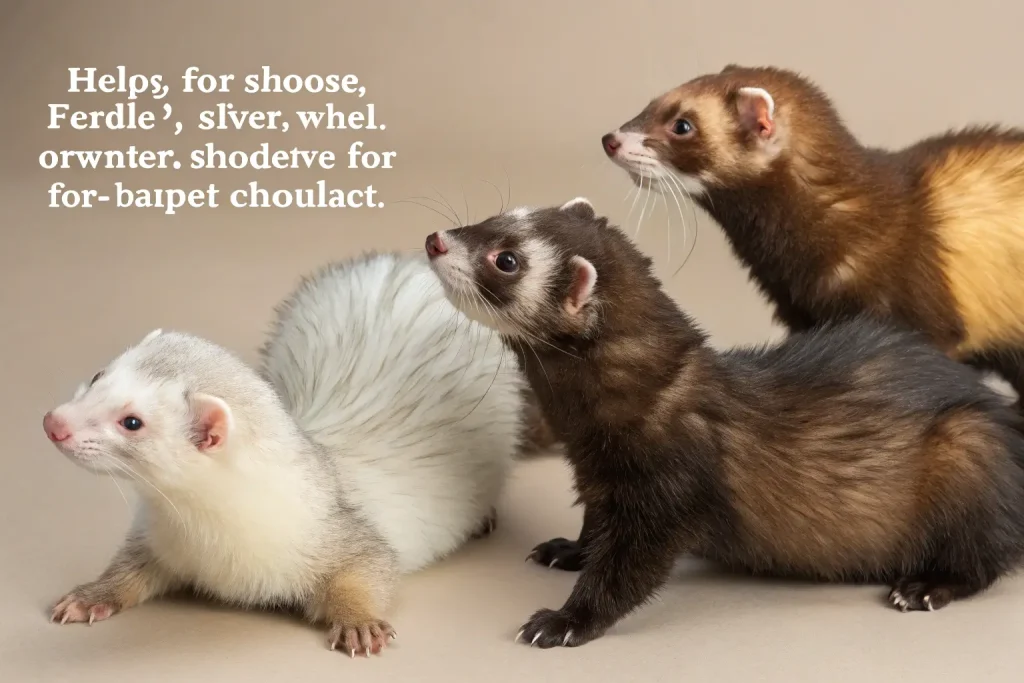
Sable Ferret
The sable ferret is the most common and traditional color variation, featuring a rich brown base coat with black guard hairs, creating a warm, dimensional appearance. Their undercoat often has creamy or yellowish tones, while their faces display a characteristic “mask” pattern with darker markings around the eyes and lighter areas on the cheeks.
Sables represent the wildtype coloration closest to their polecat ancestors. They typically have black eyes and noses, with some showing a small white bib on the chest. Most ferret colors are actually variations or dilutions of this standard sable pattern.
Albino Ferret
Albino ferrets are striking with their pure white coats and distinctive red eyes. This coloration results from a genetic mutation causing an absence of melanin production. Their pink eyes, nose, and skin are actually transparent, showing the blood vessels beneath.
While undeniably beautiful, albino ferrets require special considerations:
- They’re more sensitive to bright light due to their lack of eye pigmentation
- They sunburn more easily than darker-coated ferrets
- They may have slightly higher rates of deafness (though this is debated among breeders)
Despite these considerations, albinos make wonderfully affectionate pets with personality traits identical to their colored counterparts.
Black Sable/Self Ferret
These striking ferrets feature uniform black or very dark brown coloration throughout their coat. Unlike standard sables, black sables have minimal contrast between their guard hairs and undercoat, giving them a more solid appearance, though they may still lighten slightly at the underside.
Black sables typically retain the dark mask, paws, and tail tip characteristic of the sable pattern, just with deeper, richer pigmentation throughout. Their intense coloration makes their eyes appear particularly bright and engaging.
Chocolate Ferret
Chocolate ferrets display a warm, milk-chocolate coloration that’s actually a dilution of the black sable gene. Their guard hairs are a rich brown rather than black, and their undercoat tends toward a warmer cream color. Their eyes are often slightly lighter than standard sables, ranging from very dark brown to a warm burgundy tone.
The chocolate color tends to develop a beautiful sheen in well-nourished ferrets, showing reddish highlights in natural light. Their mask pattern is usually present but softer than in darker varieties.
Cinnamon Ferret
Cinnamon ferrets feature a stunning reddish-brown coat that’s warmer and lighter than chocolate variants. Their guard hairs have a distinctive auburn quality, while their undercoat is frequently a pale cream or buff color. The contrast between these layers gives cinnamon ferrets a particularly dimensional appearance.
Their mask is typically lighter and less defined than darker varieties, and they often show more dramatic seasonal color changes, becoming noticeably lighter in summer months. Cinnamon ferrets frequently have brown or burgundy eyes.
Champagne Ferret
Champagne ferrets display a beautiful dilute tan to light beige color with cream undercoats. This delicate coloration results from multiple dilution genes affecting the standard sable pattern. Their mask is often barely visible, appearing as a subtle tan shading against their otherwise pale faces.
Champagnes typically have burgundy to light brown eyes and pink or beige noses. Their tail tips and paws may show slightly darker shading than their body. This gentle coloration has become increasingly popular in recent years.
Silver Ferret
Silver ferrets exhibit a stunning gray to silver-white coat with darker guard hairs creating a distinctive salt-and-pepper effect. Their mask pattern ranges from barely visible to dramatically dark, depending on the individual. True silvers have burgundy to black eyes and usually dark nose pigmentation.
This color variant is often confused with the DEW (dark-eyed white) pattern, but silvers retain more visible guard hair coloration and typically show more defined patterns on their extremities.
Pattern Variations in Ferret Colors
Panda Ferret
Panda ferrets feature a dramatic white head and shoulders with colored bodies, creating a striking contrast pattern reminiscent of their namesake bear. This pattern can occur in any base color, though it’s particularly striking in darker varieties like black sable or chocolate.
True pandas have completely white heads with the color starting behind the shoulders, though variations with partial masks or colored patches are common. This distinctive pattern is genetically linked to white markings genes and often accompanies white feet or bibs.
Mitt Ferret
Mitt patterned ferrets display white “socks” on their feet, sometimes extending up their legs. The classic mitt pattern includes white on all four paws, though variations with white on just the front or back feet are common. This pattern often accompanies a white bib on the chest and sometimes a white-tipped tail.
Mitts can appear in any base color, creating endless variations. The contrast between dark body coloration and crisp white mitts creates a particularly appealing visual that many ferret enthusiasts seek out.
Blaze Ferret
Blaze ferrets feature a distinctive white stripe running from between the eyes up the forehead, sometimes extending down the back of the neck. This dramatic marking creates a “lightning bolt” appearance that stands out dramatically, especially on darker base colors.
The blaze pattern frequently accompanies other white markings like mitts or bibs, though it can appear on otherwise solid-colored ferrets. The genetic factors controlling these patterns are complex, resulting in each blaze being uniquely patterned.
How to Choose the Perfect Ferret Color
Consider Visibility Factors
When selecting ferret colors, consider practical visibility factors:
- Darker ferrets: Easier to spot on light-colored flooring and furniture
- Lighter ferrets: More visible in dimly lit areas or dark spaces
- High-contrast patterns: Easier to track when they’re on the move
For households with multiple ferrets, choosing different colors can help you quickly identify which fuzzy troublemaker is currently stealing your socks or exploring forbidden areas!
Health Considerations by Color
Some ferret colors have associated health considerations worth noting:
- White/Albino ferrets: Higher UV sensitivity, slightly increased deafness risk
- Dark-eyed white ferrets: May have Waardenburg syndrome (associated with deafness)
- Pandas and blazes: Higher rates of congenital deafness in some bloodlines
While these correlations exist, they aren’t absolute. A reputable breeder will be transparent about any health concerns linked to specific color patterns in their breeding lines.
Personality Myths vs. Reality
You may hear claims that certain ferret colors predict specific personality traits, but scientific evidence doesn’t support this. A ferret’s temperament is influenced by:
- Early socialization
- Genetic factors unrelated to coat color
- Individual personality differences
- Environment and handling
Choose your ferret based on interaction and connection rather than color-based personality myths. Each ferret, regardless of color, is a unique individual with their own distinct personality.
Ferret Color Changes Throughout Life
Kit to Adult Transitions
Ferret kits undergo dramatic color changes during maturation:
- Albino ferrets: Born pink with sparse white fur, gradually developing full coats
- Sable varieties: Often born much darker than their adult coloration
- Patterned ferrets: Masks, blazes, and other markings may shift or become more pronounced
These transitions occur primarily during the first 4-6 months, though subtle changes continue until about 1 year of age. First-time owners are often surprised by how dramatically their ferret’s appearance evolves.
Seasonal Color Changes
Ferrets experience natural seasonal coat variations:
- Winter coat: Thicker, often darker with more pronounced patterns
- Summer coat: Lighter, shorter, sometimes with reduced pattern definition
- Shedding seasons: Major coat transitions occur in spring and fall
These natural cycles explain why your ferret may look different in photographs taken months apart. Good nutrition supports healthy coat transitions and maintains optimal color vibrancy.
Caring for Different Ferret Colors
Grooming Considerations
Different ferret colors have specific grooming needs:
- White/light-colored ferrets: Show dirt more readily; may require more frequent bathing
- Dark ferrets: Show dandruff more visibly; benefit from occasional oil supplements
- All ferrets: Need regular nail trimming regardless of color
- Dense-coated varieties: Require more frequent brushing during seasonal shedding
Remember that over-bathing strips natural oils—limit baths to once monthly at most, using ferret-specific shampoos.
Diet Impact on Coat Color
A ferret’s diet significantly affects their coat color and quality:
- High-quality protein: Maintains pigment intensity and coat shine
- Essential fatty acids: Support vibrant color expression and reduce dryness
- Poor nutrition: Can cause premature graying or dull, brittle fur
Premium ferret food or high-quality kitten food provides the necessary nutrients for optimal coat health and color expression.
Conservation Status
Domestic Status
While the domestic ferret isn’t endangered, responsible breeding practices remain important for maintaining genetic diversity and health. The popularity of certain ferret colors has sometimes led to problematic breeding practices focusing on appearance over health.
Organizations like the American Ferret Association work to promote responsible breeding while preserving the wonderful variety of ferret colors and patterns.
Wild Relatives
The European polecat (Mustela putorius), the ferret’s wild ancestor, faces conservation challenges in parts of its range. Understanding the ferret’s wild heritage helps owners appreciate their pets’ natural behaviors and needs.
Interesting Facts About Ferret Colors
- The genetics controlling ferret colors are similar to those in mink, another mustelid bred for various coat colors
- A ferret’s nose color typically corresponds to their coat color (pink for light ferrets, dark for darker varieties)
- Albino ferrets were historically preferred for hunting because they were easier to spot in dim burrows
- The dramatic “roan” pattern, where white hairs gradually replace colored ones with age, is actually a form of premature graying rather than a true color pattern
- Ferrets in wildlife rehabilitation that will be released must be traditional sable coloration to prevent genetic contamination of wild polecat populations
Tips for Choosing and Caring for Your Ferret
Finding Reputable Sources
When seeking a ferret of a specific color:
- Reputable breeders: Focus on health testing and temperament alongside color
- Rescue organizations: Often have various colors available for adoption
- Avoid pet stores: These ferrets often come from mass-breeding operations with poorer health outcomes
Many prospective owners find their perfect match through ferret rescue organizations, where personality can be assessed alongside appearance.
Creating the Ideal Environment
Regardless of color, all ferrets need:
- Safe space: Ferret-proofed area for play and exploration
- Comfortable housing: Multi-level cage with appropriate bedding
- Enrichment: Toys, tunnels, and regular interaction
- Proper nutrition: High-quality ferret food and appropriate treats
- Veterinary care: Access to exotic pet veterinarians familiar with ferret health
Role in Human Companionship
Ferrets of all colors make exceptional companions for the right owners. Their playful antics, affectionate nature, and boundless curiosity create strong bonds with their human families.
Their domestication history spans cultures and continents, from ancient hunting partners to beloved modern pets. Whatever color you choose, your ferret will bring its unique personality and charm into your life.
Conclusion
Choosing the perfect ferret color is part practical consideration, part personal preference, and ultimately, an exciting first step in your ferret ownership journey. While their coloration adds to their charm, remember that health, temperament, and the connection you feel with a particular animal are far more important than coat color alone.
Whether you’re drawn to the classic elegance of a sable ferret, the striking contrast of a panda pattern, or the ethereal beauty of an albino, your ferret’s personality will quickly become their most cherished feature. Each ferret, regardless of coloration, offers the same capacity for playfulness, affection, and mischief that makes these animals such beloved companions.
As you begin your search for the perfect fuzzy friend, keep an open mind about color—sometimes the ferret that steals your heart might wear an entirely different coat than you initially imagined!
Frequently Asked Questions
Does a ferret’s color affect its personality?
No, there’s no scientific evidence linking ferret colors to specific personality traits. Individual temperament, early socialization, and genetics unrelated to coat color determine a ferret’s personality. Choose based on interaction rather than color myths.
How can I tell what color my baby ferret will be as an adult?
Baby ferrets (kits) often change color dramatically during their first 3-4 months. Look at the parents if possible, as genetics provide clues to adult coloration. Consult experienced breeders who can often predict adult coloration based on subtle kit characteristics.
Are certain ferret colors more prone to health issues?
White ferrets, particularly albinos, may have higher UV sensitivity and slightly increased deafness rates. Some pattern genes (like the wide blaze) can correlate with hearing issues. However, good breeding practices minimize these concerns, and health screening is more important than avoiding specific colors.
How many different ferret colors and patterns exist?
Experts recognize 7-10 primary ferret colors and 4-5 main pattern types. When combined, these create over 30 recognized color/pattern combinations—and countless variations within those categories! The American Ferret Association maintains detailed standards for each color variety.
Will my ferret’s color change as they age?
Yes, most ferrets experience some color change throughout life. Dramatic changes occur during the first 4-6 months, followed by seasonal variations. Many ferrets develop “roaning” (white hairs) as they age, particularly around the face, creating a distinguished appearance in senior ferrets.
